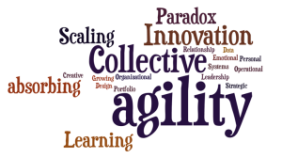 How can we map a new pathway for shifting current practices so as to transform them?
How can we map a new pathway for shifting current practices so as to transform them?
How can we bring increasing agility into our innovation work, that requires both stable and dynamic moments to deliver better outcomes?
Where do we focus, what do we recognize as organization practices, that can begin to transform the organization and re-equip it for a different future?
Agility for me is vital, it allows us to increasingly be adaptive in an uncertain world.
As innovation continues to be central to growth far more in the future it is our ability to adapt and adjust to all the uncertainties and this requires the ability to be agile.
A report provided by McKinsey “How to create an agile organization” has been part of a broader ‘agile’ series from them but this one specifically gave me my necessary anchor point, to move forward with my own design thinking for agility and innovation. Continue reading “Achieving agility within your innovation work”




